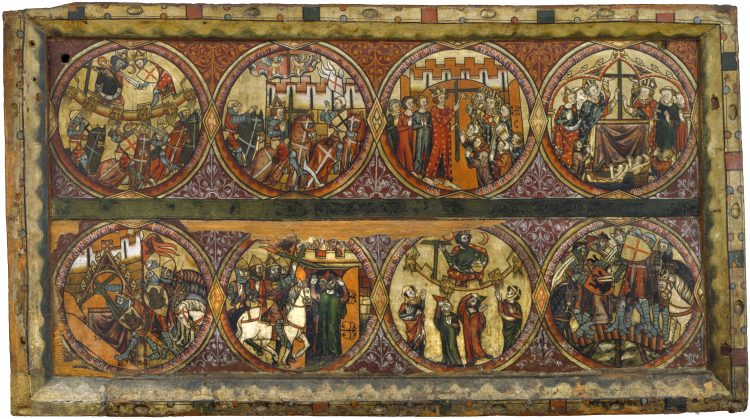This painted panel from Nedstryn was the first altar frontal to enter the Bergen collection, and the subject of the first art historical research paper published by its founder, Wilhem Frimann Koren Christie. It is composed of two wide boards set inside a frame with oval incisions. The entire surface is occupied by eight circles that narrate the robbery and recovery of the Holy Cross in the years 614-629. The cycle is remarkably extensive, and the paintings are of an artistically high quality. The scenes are surrounded by rings with inscriptions in Old Norse that explain the depicted episodes and indicate that the frontal was produced in Norway (Bergen?). The closest stylistic and compositional parallels are found overseas, for example in English and French stained glass windows and book illuminations. The same iconography occurs in the stained glass windows of the Sainte-Chapelle in Paris, that was consecrated in 1248.

The narrative starts at the bottom left, with the theft of the Cross by the Persian King Chosroes. The three following scenes to the right show how he returns with the cross to his palace where he is venerated by the people, and how his son is defeated by the Byzantine Emperor Heraclius. The upper register narrates how the king is subsequently killed by Heraclius, how Heraclius returns to Jerusalem with the recaptured cross, where his pride prevents him from finding the city gate, and how he finally enters the city humbly barefoot with the Cross in his hands, and restores it to the top of the altar.
The frontal, with its exceptional subject matter, was transferred to the museum from a small parish church in Nordfjord, which raises the question of whether it originally belonged there. The seventh-century history of the Holy Cross gained momentum again in the context of the Crusades, implying a call to liberate the sacred places in Palestine just as Heraclius had done. Seen in this light, it seems more plausible that the frontal originally belonged to a church in the centre of political power Bergen, such as the Apostles’ church at the royal residence. It might have reached Nedstryn only after the Reformation, when that church was demolished.
Norway (Bergen?), 1300-1325
From Nedstryn (Nordfjord), in the museum since 1826
Pinewood, painted
H 98 cm x W 174.5 x D 7.5 cm
Inv. no. MA 1
